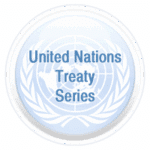A treaty does not enter into force when it is adopted.
Typically, the provisions of the treaty determine the date on which the treaty enters into force, often at a specified time following its ratification or accession by a fixed number of States.
For example, the Convention on the Rights of the Child entered into force on 2 September 1990—the 30th day following the deposit of the 20th State’s instrument of ratification or accession. A treaty enters into force only for those states which gave the required consent.
Entry into force in the EUCLID context
Both 49006 and 49007 entered into force upon second signature, which is the default mechanism:
Open Memorandum of Understanding (MOU) between the Participating EUCLID Parties regarding their Participation in the Educational Framework defined
herein (with annex). New York, 5 March 2008
Entry into force: 16 April 2008, in accordance with articles III and VI
Updated Framework Agreement regarding the Parties’ Participation in EUCLID as Constituted and Defined herein. New York, 28 July 2009
Entry into force: 3 September 2009, in accordance with article VI
Entry into Force of Treaties: A Guide Based on the Vienna Convention on the Law of Treaties (1969)
Introduction
In international law, treaties serve as the primary instruments for establishing binding agreements between states. However, a treaty does not automatically become legally enforceable upon its signing or adoption. The concept of “entry into force” refers to the moment when a treaty begins to have legal effect for the parties involved. This process is governed by customary international law and has been codified in the Vienna Convention on the Law of Treaties (VCLT), adopted in 1969 and entered into force in 1980. The VCLT provides a comprehensive framework for treaty-making, including detailed provisions on how treaties come into operation.
The VCLT, often regarded as the “treaty on treaties,” outlines rules that apply to written agreements between states, emphasizing flexibility while ensuring clarity and predictability. This article explores the mechanisms of entry into force, drawing directly from the relevant articles of the VCLT to explain the general principles, specific procedures, and exceptions.
The General Rule: Flexibility in Entry into Force
According to the VCLT, the entry into force of a treaty is primarily determined by the treaty’s own terms or by agreement among the negotiating states. Article 24(1) states: “A treaty enters into force in such manner and upon such date as it may provide or as the negotiating States may agree.” This provision underscores the principle of party autonomy, allowing states to tailor the entry into force to suit the treaty’s nature—whether bilateral (between two states) or multilateral (involving multiple states).
For instance, many bilateral treaties enter into force upon the exchange of instruments of ratification, a process where states formally confirm their consent after domestic approval. In contrast, multilateral treaties often require a specified number of ratifications or accessions before becoming operational. A common example is the United Nations Charter, which entered into force after ratification by the permanent members of the Security Council and a majority of other signatories, though this predates the VCLT.
If the treaty itself is silent on the matter and no separate agreement exists, Article 24(2) provides a default rule: “Failing any such provision or agreement, a treaty enters into force as soon as consent to be bound by the treaty has been established for all the negotiating States.” This ensures that treaties do not remain in limbo indefinitely, promoting efficiency in international relations.
Consent to Be Bound: The Prerequisite for Entry into Force
Entry into force is inextricably linked to the concept of consent, as a treaty only binds states that have expressed their willingness to be bound. The VCLT dedicates Section 1 of Part II to the “Conclusion of Treaties,” where Articles 11–17 detail the means by which states express consent.
- Article 11 lists various methods for expressing consent, including signature, exchange of instruments, ratification, acceptance, approval, accession, or any other agreed means. This flexibility accommodates different domestic legal systems and treaty types.
- Signature (Article 12): In some cases, a representative’s signature alone can express consent if the treaty specifies it or if the negotiating states agree. Initialing or signing “ad referendum” (subject to confirmation) can also suffice under certain conditions.
- Exchange of Instruments (Article 13): For treaties formed by exchanged documents, consent is established upon the exchange if so provided or agreed.
- Ratification, Acceptance, or Approval (Article 14): These are common for treaties requiring domestic legislative approval. Ratification is required if the treaty demands it, if agreed by negotiators, or if signed subject to ratification.
- Accession (Article 15): This allows states not involved in negotiations to join later, typically for multilateral treaties. Consent is expressed by depositing an instrument of accession.
Once consent is established through these means—often via deposit with a designated depositary (e.g., the UN Secretary-General)—the treaty can enter into force as per Article 24.
For states joining after initial entry into force, Article 24(3) clarifies: “When the consent of a State to be bound by a treaty is established on a date after the treaty has come into force, the treaty enters into force for that State on that date, unless the treaty otherwise provides.” This prevents retroactive application unless specified.
Additionally, Article 24(4) ensures that certain preparatory provisions—such as those on authentication, consent establishment, and depositary functions—apply from the treaty’s adoption, even before full entry into force.
Provisional Application: A Bridge to Full Entry into Force
In some scenarios, treaties may need to take effect before formal entry into force, such as in urgent situations. Article 25 addresses this through provisional application. A treaty or part of it can be applied provisionally if the treaty provides for it or if negotiating states agree otherwise. This is terminated if a state notifies others of its intent not to join, unless otherwise agreed.
Provisional application is increasingly used in modern treaties, like trade agreements or environmental pacts, to implement measures while ratification processes unfold.
Special Considerations for Multilateral Treaties
Multilateral treaties often include clauses requiring a minimum number of ratifications for entry into force, reflecting the need for broad participation. The VCLT itself required 35 instruments of ratification or accession to enter into force, which occurred on January 27, 1980. This “Vienna formula” has influenced subsequent treaties, ensuring they gain sufficient support before becoming binding.
Conclusion
The entry into force of a treaty marks the transition from negotiation to obligation, ensuring that international commitments are not merely aspirational but enforceable. The Vienna Convention on the Law of Treaties (1969) provides a balanced, state-centric approach, prioritizing the treaty’s provisions while offering default rules for clarity. By referencing Articles 24 and 25, along with those on consent (11–17), the VCLT promotes predictability in global diplomacy. Understanding these mechanisms is essential for states, scholars, and practitioners navigating the complexities of international law. As treaties continue to evolve in addressing global challenges, the principles enshrined in the VCLT remain foundational.






